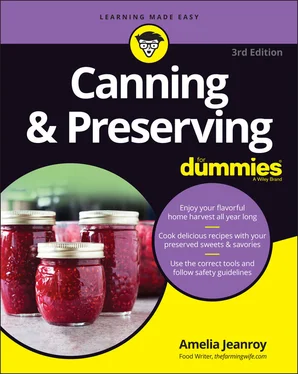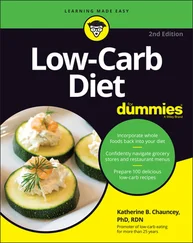 These bits of technical information are interesting, but you can skip them if you want to. Of course, the info contained in these paragraphs makes you seem like you’ve been canning and preserving since you’ve been walking.
These bits of technical information are interesting, but you can skip them if you want to. Of course, the info contained in these paragraphs makes you seem like you’ve been canning and preserving since you’ve been walking.
In addition to the abundance of information and guidance related to canning and preserving food that we provide in this book, you get access to even more help and information online at Dummies.com . Check out this book’s online Cheat Sheet. Just go to www.dummies.com and search for “Canning & Preserving For Dummies Cheat Sheet.”
Although you can start in any portion of this book, don’t skip Chapter 3. It describes safe processing methods and tells you how to identify spoiled food. If you have any doubts about canning and preserving safety, this chapter puts your fears at ease.
If you want to know about a particular food-preservation method, go to the part devoted to that method. Each one begins with a chapter that explains the technique. Review these initial chapters before selecting a recipe to make sure you have a decent idea what that particular food preservation method requires. If you still can’t decide where to start, review the recipes and start with one that sounds good to you! Then just back-track to the general techniques chapter as you need to. If you’d like to make the Pickled Dilly Beans recipe in Chapter 8, for example, check out Chapter 4for the basics on water-bath canning. If you want to dehydrate strawberries (you find the recipe in Chapter 17), check out Chapter 16for general dehydrating information.
And if you want to jump right in? Go to the Recipes at a Glance page to find a recipe that sparks your interest.
Part 1
IN THIS PART …
Discover the benefits of canning and preserving your own foods.
Find the best tools for each type of food preservation.
Dispel the rumors you may have heard about preserving food.
Grasp how and why safety recommendations exist for all types of recipes.
Chapter 1
A Quick Overview of Canning and Preserving
IN THIS CHAPTER
 Discovering the world of canning and preserving
Discovering the world of canning and preserving
 Understanding the whys and hows of canning and preserving
Understanding the whys and hows of canning and preserving
 Preparing yourself for safely canning and preserving your foods
Preparing yourself for safely canning and preserving your foods
 Becoming a successful food canner and preserver
Becoming a successful food canner and preserver
Over the years, because of our busy lifestyles and the convenience of refrigeration and supermarkets, the art of canning and preserving has declined. Other than jams and jellies, many people started thinking of canning as sort of a novelty hobby. But today, there is a renewed interest in learning this art. People are now more concerned about food shortages, and are starting, or expanding on, home gardens. People also want to have more control over, and knowledge about, where their food comes from. As a result, more people are finding that canning and preserving foods is an inexpensive and easy way to keep a full pantry year-round.
This chapter gives you an overview of the four canning and preserving techniques presented in this book — water-bath canning, pressure canning, freezing, and dehydrating — and explains the benefits, both practical and emotional, that canning and preserving your own foods can provide.
If you’re new to canning and preserving, don’t be overwhelmed or scared off by the rules. This book walks you through easy, step-by-step instructions for each technique. After you understand the basic procedures for a method, like water-bath canning, it’s just a matter of concentrating on closely following your recipe.
Appreciating the Benefits of Canning and Preserving Your Own Food
Canning and preserving are ways to protect food from spoilage so you can use it at a later time. Some methods, like dehydrating (also referred to as drying), date back to ancient times; others, like canning, are a little more recent. There’s no doubt that being able to offer fresh-tasting, home-canned or home-preserved foods to your family and friends throughout the year is definitely satisfying.
Whatever food-preservation method you choose (this book covers canning, freezing, dehydrating, and cold storage), your efforts will give you the following:
A pantry full of freshly preserved, homegrown foods. Having a stocked pantry offers a cushion against the fluctuating cost and availability of healthy foods. If you enjoy specialty foods from gourmet stores but dislike the high prices, home-canning is a safe and economical way to preserve large or small quantities of high-quality food.
Convenience. You can build a pantry of convenience foods that fit into your busy lifestyle and that your family will enjoy.
Confidence in the ingredients that go into your food. If you love fresh ingredients and like to know what goes into your food, doing your own canning and preserving is the answer.
Protection against rising food costs and temporary shortages. The whole idea of canning and preserving is to take advantage of fresh food when it’s abundant. And abundant food generally means lower costs. If there is a temporary shortage of food, you will have what you need in your pantry.
A sense of relaxation and accomplishment. For many people, working in the kitchen and handling food provides a sense of relaxation, and watching family and friends enjoy the products of your efforts gives you a great sense of accomplishment. Taking the time to select your recipe, choosing and preparing your food, and packaging and processing it for safety is fulfilling and a source of pride for you, the home-canner.
A good time. Producing canned and preserved food in your kitchen is fun and easy — and who doesn’t like fun?
 The price of food has skyrocketed in the last few years. Food safety and availability have become a concern for everyone. Canning is the answer to both the price dilemma and the desire to offer nutritious foods throughout the year. Home-canning and home-preserving instantly reward your efforts when you follow the proper steps for handling and processing your food.
The price of food has skyrocketed in the last few years. Food safety and availability have become a concern for everyone. Canning is the answer to both the price dilemma and the desire to offer nutritious foods throughout the year. Home-canning and home-preserving instantly reward your efforts when you follow the proper steps for handling and processing your food.
Although home-canning and home-preserving have skipped one or two generations, one thing is certain: They are on the rise. Men and women of all ages practice the art of home-canning. It no longer matters whether you live in the country or in the city or if you grow your own food. Fresh ingredients are available just about everywhere. Farmer’s markets are commonplace in many cities and towns, making it easy to find the perfect foods to preserve for an affordable price.
Exact statistics regarding home-canning vary, but today, most home-canned products are used in the home where they’re produced. In addition, a rising number of people are committed to eating locally, and these folks want to know what is in the foods they eat. By preserving their own foods, they can find the freshest food available and control what goes in their food.
Читать дальше

 These bits of technical information are interesting, but you can skip them if you want to. Of course, the info contained in these paragraphs makes you seem like you’ve been canning and preserving since you’ve been walking.
These bits of technical information are interesting, but you can skip them if you want to. Of course, the info contained in these paragraphs makes you seem like you’ve been canning and preserving since you’ve been walking. Discovering the world of canning and preserving
Discovering the world of canning and preserving The price of food has skyrocketed in the last few years. Food safety and availability have become a concern for everyone. Canning is the answer to both the price dilemma and the desire to offer nutritious foods throughout the year. Home-canning and home-preserving instantly reward your efforts when you follow the proper steps for handling and processing your food.
The price of food has skyrocketed in the last few years. Food safety and availability have become a concern for everyone. Canning is the answer to both the price dilemma and the desire to offer nutritious foods throughout the year. Home-canning and home-preserving instantly reward your efforts when you follow the proper steps for handling and processing your food.










